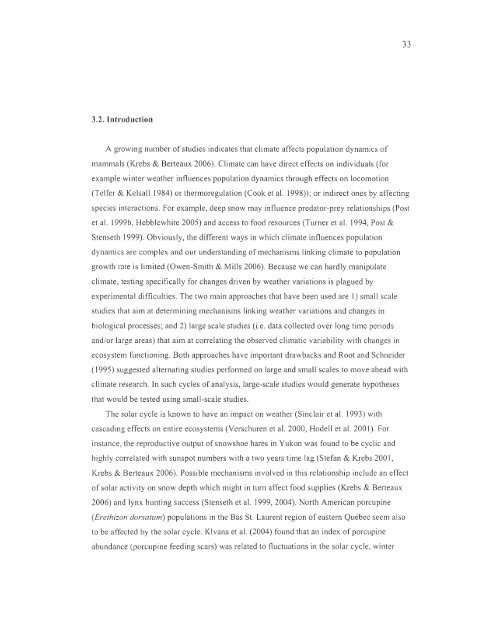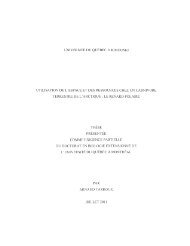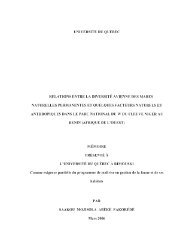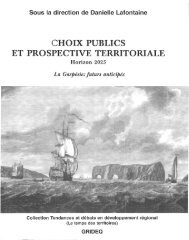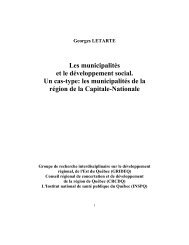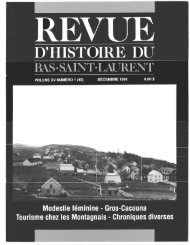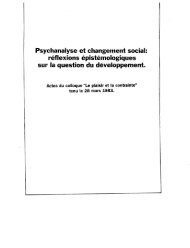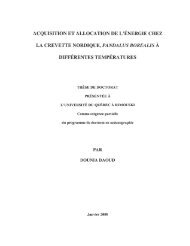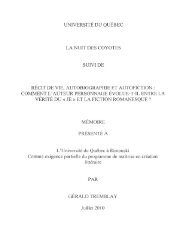influence du climat et de la prédation sur l'utilisation de l'habitat et la ...
influence du climat et de la prédation sur l'utilisation de l'habitat et la ...
influence du climat et de la prédation sur l'utilisation de l'habitat et la ...
Create successful ePaper yourself
Turn your PDF publications into a flip-book with our unique Google optimized e-Paper software.
33<br />
3.2. Intro<strong>du</strong>ction<br />
A growing number of studies indicates that <strong>climat</strong>e affects popu<strong>la</strong>tion dynamics of<br />
mammals (Krebs & Be11eaux 2006). Climate can have direct effects on indivi<strong>du</strong>als (for<br />
example winter weather <strong>influence</strong>s popu<strong>la</strong>tion dynamics through effects on locomotion<br />
(Telfer & Kelsall 1984) or thermoregu<strong>la</strong>tion (Cook <strong>et</strong> al. 1998)); or indirect ones by affecting<br />
species interactions. For example, <strong>de</strong>ep snow may <strong>influence</strong> predator-prey re<strong>la</strong>tionships (Post<br />
<strong>et</strong> al. 1999b, Hebblewhite 2005) and access to food resources (Turner <strong>et</strong> al. 1994, Post &<br />
Stens<strong>et</strong>h 1999). Obviously, the different ways in which <strong>climat</strong>e <strong>influence</strong>s popu<strong>la</strong>tion<br />
dynamics are complex and our un<strong>de</strong>rstanding of mechanisms linking <strong>climat</strong>e to popu<strong>la</strong>tion<br />
growth rate is limited (Owen-Smith & Mills 2006). Because we can hardly manipu<strong>la</strong>te<br />
<strong>climat</strong>e, testing specifically for changes driven by weather variations is p<strong>la</strong>gued by<br />
experimental difficulties. The two main approaches that have been used are 1) small scale<br />
studies that aim at d<strong>et</strong>ermining mechanisms linking weather variations and changes in<br />
biological processes; and 2) <strong>la</strong>rge scale studies (i.e. data collected over long time periods<br />
and/or <strong>la</strong>rge areas) that aim at corre<strong>la</strong>ting the observed <strong>climat</strong>ic variability with changes in<br />
ecosystem functioning. Both approaches have important drawbacks and Root and Schnei<strong>de</strong>r<br />
(1995) suggested alternating studies performed on <strong>la</strong>rge and small scales to move ahead with<br />
<strong>climat</strong>e research. ln such cycles of analysis, <strong>la</strong>rge-scale studies would generate hypotheses<br />
that wou Id be tested using small-scale studies.<br />
The so<strong>la</strong>r cycle is known to have an impact on weather (Sinc<strong>la</strong>ir <strong>et</strong> al. 1993) with<br />
cascading effects on entire ecosystems (Verschuren <strong>et</strong> al. 2000, Ho<strong>de</strong>ll <strong>et</strong> al. 2001). For<br />
instance, the repro<strong>du</strong>ctive output of snowshoe hares in Yukon was found to be cyclic and<br />
highly corre<strong>la</strong>ted with sunspot numbers with a two years time <strong>la</strong>g (Stefan & Krebs 200 l,<br />
Krebs & Be11eaux 2006). Possible mechanisms involved in this re<strong>la</strong>tionship inclu<strong>de</strong> an effect<br />
of so<strong>la</strong>r activity on snow <strong>de</strong>pth which might in turn affect food supplies (Krebs & Berteaux<br />
2006) and lynx hunting success (Sten s<strong>et</strong>h <strong>et</strong> al. 1999,2004). North American porcupine<br />
(Er<strong>et</strong>hizon dorsatum) popu<strong>la</strong>tions in the Bas St. Laurent region of eastern Québec seem also<br />
to be affected by the so<strong>la</strong>r cycle. Klvana <strong>et</strong> al. (2004) found that an in<strong>de</strong>x of porcupine<br />
abundance (porcupine feeding scars) was re<strong>la</strong>ted to fluctuations in the so<strong>la</strong>r cycle, winter


